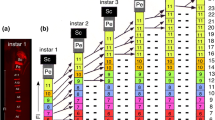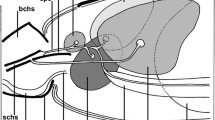Abstract
The honeybee hypopharyngeal gland consists in numerous units, each comprising a secretory cell and a canal cell. The secretory cell discharges its products into a convoluted tubular membrane system, the canaliculus, which is surrounded at regular intervals by rings of actin filaments. Using probes for various membrane components, we analyze the organization of the secretory cells relative to the apicobasal configuration of epithelial cells. The canaliculus was defined by labeling with an antibody against phosphorylated ezrin/radixin/moesin (pERM), a marker protein for the apical membrane domain of epithelial cells. Anti-phosphotyrosine visualizes the canalicular system, possibly by staining the microvillar tips. The open end of the canaliculus leads to a region in which the secretory cell is attached to the canal cell by adherens and septate junctions. The remaining plasma membrane stains for Na,K-ATPase and spectrin and represents the basolateral domain. We also used fluorophore-tagged phalloidin, anti-phosphotyrosine and anti-pERM as probes for the canaliculus in order to describe fine-structural changes in the organization of the canalicular system during the adult life cycle. These probes in conjunction with fluorescence microscopy allow the fast and detailed three-dimensional analysis of the canalicular membrane system and its structural changes in a developmental mode or in response to environmental factors.







Similar content being viewed by others
References
Albert S, Spaethe J, Grübel K, Rössler W (2014) Royal jelly-like protein localization reveals differences in hypopharyngeal glands buildup and conserved expression pattern in brains of bumblebees and honeybees. Biol Open 3:281–288
Aschenbrenner S, Walz B (1998) Pleated septate junctions in leech photoreceptors: ultrastructure, arrangement of septa, gate and fence functions. Cell Tissue Res 293:253–269
Baumann O (1998) Association of spectrin with a subcompartment of the endoplasmic reticulum in honeybee photoreceptor cells. Cell Motil Cytoskeleton 41:74–86
Baumann O (2001) Distribution of nonmuscle myosin-II in honeybee photoreceptors and its possible role in maintaining compound eye architecture. J Comp Neurol 435:364–378
Baumann O, Bauer A (2013) Development of apical membrane organization and V-ATPase regulation in blowfly salivary glands. J Exp Biol 216:1225–1234
Baumann O, Lutz K (2006) Photoreceptor morphogenesis in the Drosophila compound eye: R1-R6 rhabdomeres become twisted just before eclosion. J Comp Neurol 498:68–79
Baumann O, Takeyasu K (1993) Polarized distribution of Na, K-ATPase in honeybee photoreceptors is maintained by interaction with glial cells. J Cell Sci 105:287–301
Baumann O, Walz B (1989) Topography of the Ca2+-sequestering endoplasmic reticulum in photoreceptors and pigmented glial cells in the compound eye of the honeybee drone. Cell Tissue Res 255:511–522
Baumann O, Dames P, Kühnel D, Walz B (2002) Distribution of serotonergic and dopaminergic nerve fibers in the salivary gland complex of the cockroach Periplaneta americana. BMC Physiol 2:9
Beams H, Tahmisian T, Anderson E, Devine R (1959) An electron microscope study on the pharyngeal glands of the honeybee. J Ultrastruct Res 3:155–170
Bennett V, Healy J (2009) Membrane domains based on ankyrin and spectrin associated with cell-cell interactions. Cold Spring Harb Perspect Biol 1:a003012
Bonfanti P, Colombo A, Heintzelman MB, Mooseker MS, Camatini M (1992) The molecular architecture of an insect midgut brush border cytoskeleton. Eur J Cell Biol 57:298–307
Bretscher A, Reczek D, Berryman M (1997) Ezrin: a protein requiring conformational activation to link microfilaments to the plasma membrane in the assembly of cell surface structures. J Cell Sci 110:3011–3028
Britto FB, Caetano FH (2008) Ultrastructural features of the hypopharyngeal glands in the social wasp Polistes versicolor (Hymenoptera: Vespidae). Insect Sci 15:277–284
Bucekova M, Valachova I, Kohutova L, Prochazka E, Klaudiny J, Majtan J (2014) Honeybee glucose oxidase—its expression in honeybee workers and comparative analyses of its content and H2O2-mediated antibacterial activity in natural honeys. Naturwissenschaften 101:661–670
Byers TJ, Dubreuil R, Branton D, Kiehart DP, Goldstein LS (1987) Drosophila spectrin. II. Conserved features of the α-subunit are revealed by analysis of cDNA clones and fusion proteins. J Cell Biol 105:2103–2110
Chorna-Ornan I, Tzarfaty V, Ankri-Eliahoo G, Joel-Almagor T, Meyer NE, Huber A, Payre F, Minke B (2005) Light-regulated interaction of Dmoesin with TRP and TRPL channels is required for maintenance of photoreceptors. J Cell Biol 171:143–152
Cruz-Landim C, Costa RAC (1998) Structure and function of the hypopharyngeal glands of Hymenoptera: a comparative approach. J Comp Biol 3:151–163
Deseyn J, Billen J (2005) Age-dependent morphology and ultrastructure of the hypopharyngeal gland of Apis mellifera workers (Hymenoptera, Apidae). Apidologie 36:49–57
Dubreuil RR, Grushko T (1998) Genetic studies of spectrin: new life for a ghost protein. Bioessays 20:875–878
Dubreuil RR, MacVicar GR, Maddux PB (1997) Functional studies of the membrane skeleton in Drosophila: identification of a positional cue that targets polarized membrane skeleton assembly. Soc Gen Physiol Ser 52:91–106
Fehon RG, McClatchey AI, Bretscher A (2010) Organizing the cell cortex: the role of ERM proteins. Nat Rev Mol Cell Biol 11:276–287
Feng M, Fang Y, Li J (2009) Proteomic analysis of honeybee worker (Apis mellifera) hypopharyngeal gland development. BMC Genomics 10:645
Fujita T, Kozuka-Hata H, Ao-Kondo H, Kunieda T, Oyama M, Kubo T (2013) Proteomic analysis of the royal jelly and characterization of the functions of its derivation glands in the honeybee. J Proteome Res 12:404–411
Genova JL, Fehon RG (2003) Neuroglian, gliotactin, and the Na+/K+ ATPase are essential for septate junction function in Drosophila. J Cell Biol 161:979–989
Golovnina K, Blinov A, Akhmametyeva EM, Omelyanchuk LV, Chang LS (2005) Evolution and origin of merlin, the product of the Neurofibromatosis type 2 (NF2) tumor-suppressor gene. BMC Evol Biol 5:69
Gundersen D, Orlowski J, Rodriguez-Boulan E (1991) Apical polarity of Na, K-ATPase in retinal pigment epithelium is linked to a reversal of the ankyrin-fodrin submembrane cytoskeleton. J Cell Biol 112:863–872
Halberstadt K (1970) A study on the ultrastructure and functional cycle of the pharyngeal glands of the honey bee (Apis mellifica L.). Cytobiologie 2:341–358
Hannezo E, Dong B, Recho P, Joanny JF, Hayashi S (2015) Cortical instability drives periodic supracellular actin pattern formation in epithelial tubes. Proc Natl Acad Sci U S A 112:8620–8625
Hatjina F, Papaefthimiou C, Charistos L, Dogaroglu T, Bouga M, Emmanouil C, Arnold G (2013) Sublethal doses of imidacloprid decreased size of hypopharyngeal glands and respiratory rhythm of honeybees in vivo. Apidologie 44:467–480
Heylen K, Gobin B, Arckens L, Huybrechts R, Billen J (2011) The effects of four crop protection products on the morphology and ultrastructure of the hypopharyngeal gland of the European honeybee, Apis mellifera. Apidologie 42:103–116
Hirokawa N, Cheney RE, Willard M (1983) Location of a protein of the fodrin-spectrin-TW260/240 family in the mouse intestinal brush border. Cell 32:953–965
Hughes SC, Fehon RG (2007) Understanding ERM proteins—the awesome power of genetics finally brought to bear. Curr Opin Cell Biol 19:51–56
Just F, Walz B (1994) Immunocytochemical localization of Na+/K+-ATPase and V-H+-ATPase in the salivary glands of the cockroach, Periplaneta americana. Cell Tissue Res 278:161–170
Kamakura M (2011) Royalactin induces queen differentiation in honeybees. Nature 473:478–483
Karagiosis SA, Ready DF (2004) Moesin contributes an essential structural role in Drosophila photoreceptor morphogenesis. Development 131:725–732
Kheyri H, Cribb BW, Reinhard J, Claudianos C, Merritt DJ (2012) Novel actin rings within the secretory cells of honeybee royal jelly glands. Cytoskeleton 69:1032–1039
Kheyri H, Cribb BW, Merritt DJ (2013) Comparing the secretory pathway in honeybee venom and hypopharyngeal glands. Arthropod Struct Dev 42:107–114
Knecht D, Kaatz HH (1990) Patterns of larval food production by hypopharyngeal glands in adult worker honey bees. Apidologie 21:457–468
Knust E (2000) Control of epithelial cell shape and polarity. Curr Opin Genet Dev 10:471–475
Laprise P, Tepass U (2011) Novel insights into epithelial polarity proteins in Drosophila. Trends Cell Biol 21:401–408
Lebovitz RM, Takeyasu K, Fambrough DM (1989) Molecular characterization and expression of the Na+ + K+-ATPase alpha-subunit in Drosophila melanogaster. EMBO J 8:193–202
Matusek T, Djiane A, Jankovics F, Brunner D, Mlodzik M, Mihály J (2006) The Drosophila formin DAAM regulates the tracheal cuticle pattern through organizing the actin cytoskeleton. Development 133:957–966
McClatchey AI (2014) ERM proteins at a glance. J Cell Sci 127:3199–3204
Morita H, Ikeda T, Kajita K, Fujioka K, Mori I, Okada H, Uno Y, Ishizuka T (2012) Effect of royal jelly ingestion for six months on healthy volunteers. Nutr J 11:77
Ohashi K, Natori S, Kubo T (1999) Expression of amylase and glucose oxidase in the hypopharyngeal gland with an age-dependent role change of the worker honeybee (Apis mellifera L.). Eur J Biochem 265:127–133
Painter TS, Biesele JJ (1966) The fine structure of the hypopharyngeal gland cell of the honey bee during development and secretion. Proc Natl Acad Sci U S A 55:1414–1419
Patel NG, Haydak MH, Gochnauer TA (1960) Electrophoretic components of the proteins in honeybee larval food. Nature 186:633–634
Paul SM, Ternet M, Salvaterra PM, Beitel GJ (2003) The Na+/K+ ATPase is required for septate junction function and epithelial tube-size control in the Drosophila tracheal system. Development 130:4963–4974
Planta A von (1888) Über den Futtersaft der Bienen. Hoppe Seylers Z Physiol Chem 12:327–354
Polesello C, Payre F (2004) Small is beautiful: what flies tell us about ERM protein function in development. Trends Cell Biol 14:294–302
Polesello C, Delon I, Valenti P, Ferrer P, Payre F (2002) Dmoesin controls actin-based cell shape and polarity during Drosophila melanogaster oogenesis. Nat Cell Biol 4:782–789
Rahman S, Thangkhiew I, Hajong SR (2014) Hypopharyngeal gland activity in task-specific workers under brood and broodless conditions in Apis cerana indica (Fab.). J Apicult Sci 58:59–70
Robinson DN, Cant K, Cooley L (1994) Morphogenesis of Drosophila ovarian ring canals. Development 120:2015–2025
Sagili RR, Pankiw T, Zhu-Salzman K (2005) Effects of soybean trypsin inhibitor on hypopharyngeal gland protein content, total midgut protease activity and survival of the honey bee (Apis mellifera L.). J Insect Physiol 51:953–957
Snodgrass RE (1956) Anatomy of the honeybee. Cornell University Press, Ithaca
Tepass U (2012) The apical polarity protein network in Drosophila epithelial cells: regulation of polarity, junctions, morphogenesis, cell growth, and survival. Annu Rev Cell Dev Biol 28:655–685
Tilney LG, Tilney MS, Guild GM (1996) Formation of actin filament bundles in the ring canals of developing Drosophila follicles. J Cell Biol 133:61–74
Ueno T, Takeuchi H, Kawasaki K, Kubo T (2015) Changes in the gene expression profiles of the hypopharyngeal gland of worker honeybees in association with worker behavior and hormonal factors. PLoS One 10:e0130206
Xu N, Bagumian G, Galiano M, Myat MM (2011) Rho GTPase controls Drosophila salivary gland lumen size through regulation of the actin cytoskeleton and moesin. Development 138:5415–5427
Zimmermann B (2000) Subcellular organization of agonist-evoked Ca2+ waves in the blowfly salivary gland. Cell Calcium 27:297–307
Zimmermann B, Dames P, Walz B, Baumann O (2003) Distribution and serotonin-induced activation of vacuolar-type H+-ATPase in the salivary glands of the blowfly Calliphora vicina. J Exp Biol 206:1867–1876
Acknowledgments
Anti-spectrin antiserum was generously provided by Daniel Branton. Monoclonal antibodies α5, 4F3, C566.9, C615.16 and DCAD2, as developed by Douglas M. Fambrough, Corey Goodman, Richard G. Fehon and Tadashi Uemura, respectively, were obtained from the Developmental Studies Hybridoma Bank, created by the NICHD of the NIH and maintained at The University of Iowa, Department of Biology, Iowa City, Iowa, USA. We are grateful to Carl Zeiss Microscopy for providing access to a LSM880-Airyscan, to Ricarda Scheiner for providing honeybees and to Bärbel Wuntke for technical assistance.
Author information
Authors and Affiliations
Corresponding author
Additional information
This work was funded in part by Grant BL 469/7-1 from the German Science Foundation to W.B.
Rights and permissions
About this article
Cite this article
Richter, K.N., Rolke, D., Blenau, W. et al. Secretory cells in honeybee hypopharyngeal gland: polarized organization and age-dependent dynamics of plasma membrane. Cell Tissue Res 366, 163–174 (2016). https://doi.org/10.1007/s00441-016-2423-9
Received:
Accepted:
Published:
Issue Date:
DOI: https://doi.org/10.1007/s00441-016-2423-9




